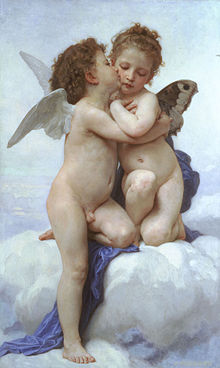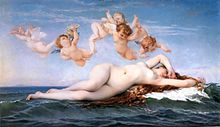Academic art

The Academic Art , also Academic realism or academicism , rare academic character called, was a European style of art from the 17th to the 19th centuries. He put his emphasis on strict adherence to the formal, technical and aesthetic rules of the art academies .
Academic art includes paintings and sculptures that were created under the influence of the European academies, where many artists of this time received their formal training. Academic art focused on a predominantly literary, mythologically and historically motivated canon of permissible or desirable topics. Their artists showed no interest in depicting the mundane or profane. Thus academic art is not realistic but idealistic .
Stylistically, academic art cultivated the ideal of perfect and at the same time selective imitation of reality ( mimesis ), which had existed since Aristotle . With perfect mastery of color, light and shadow, shapes were worked out in a quasi-photo-realistic manner. Some paintings have a "polished finish" where you can no longer see a brushstroke on the finished work. This ideal of art was shaken to its foundations in the middle of the 19th century by the invention of photography .
The French École des Beaux-Arts , which was under the influence of Neoclassicism and Romanticism , was particularly influential for the style . The academic art of later times synthesized these two styles, which can be seen very well in the paintings of William Adolphe Bouguereau , Thomas Couture and Hans Makart .
With the emergence of later art styles, particularly impressionism , academic art was despised and dismissed as " eclecticism ". From the beginning to the end of the 20th century, most art experts regarded it as negligible, so it was hardly mentioned and disappeared in museum depots; occasionally they were disparagingly called “ art pompier ”. In addition, the academic style of painting was discredited by the fact that it was elevated to the absolute standard by the National Socialist art policy. Only a few, mostly older, artists remained loyal to her until the 1960s.
It was not until the 1990s that the academic art of the fin de siècle was gradually "rediscovered" and has since gained increasing appreciation. While painting went its own way by reflecting on and questioning its own prerequisites, historical film in particular, especially the sandal film , continued the academic pleasure in reconstructing the past.
Important representatives
- France
- Louis-Ernest Barrias , sculptor
- Paul Baudry , painter
- Léon Bonnat , painter
- William Adolphe Bouguereau , painter
- Jules Breton , painter
- Alexandre Cabanel , painter
- Albert-Ernest Carrier-Belleuse , sculptor
- Charles Joshua Chaplin , painter
- Thomas Couture , painter
- Alexandre-Gabriel Decamps , painter
- Paul Delaroche , painter
- Émilie Desjeux , painter and portraitist
- Alexandre Falguière , sculptor
- Jean-Léon Gérôme , painter and sculptor
- Jean Jacques Henner , painter
- Marius Jean Antonin Mercié , sculptor
- Aimé Morot , painter
- Isidore Pils , painter
- Georges-Antoine Rochegrosse , painter
- Jean Victor Schnetz , painter
- Belgium
- Hendrik Leys , painter
- Alfred Stevens , painter
- Germany
- Anselm Feuerbach , painter
- Wilhelm von Kaulbach , painter
- Franz von Lenbach , painter
- Karl von Piloty , painter
- England
- Sir Lawrence Alma-Tadema , painter
- Sir Alfred Gilbert , sculptor
- John William Godward , painter
- Frederic Leighton , painter and sculptor
- Albert Joseph Moore , painter
- George Frederic Watts , painter
- Greece
- Georgios Jakobides , painter
- Netherlands
- Ary Scheffer , eraser and sculptor
- Austria
- Hans Canon , painter
- Hans Makart , painter
- Viktor Tilgner , sculptor
- Bohemia
- Václav Brožík , painter
- Josef Malinský , sculptor and carver
- Poland
- Henryk Siemiradzki , painter
- Russia
- Karl Brjullow , painter
- Alexander Ivanov , painter
- Konstantin Makowski , painter
- Switzerland
- Charles Gleyre , painter
- Spain
- Marià Fortuny , painter
- Italy
- Francesco Hayez , painter
literature
- Gérard Monnier: L'Art et ses institutions en France de la Révolution à nos jours. Paris: Gallimard 1995 (provides an overview of French art and the art system in the 19th century)
Web links
- The Art Renewal Center , the largest online museum dedicated to academic art
- Dahesh Museum of Academic Art in New York, USA
- Bridgeview School of Fine Art in New York, which emphasizes academic training
- Nineteenth-Century Art Worldwide
Remarks
- ↑ Beyar's Art Dictionary
- ↑ Zimmermann & Heitmann -Kunsthaus Blog
- ↑ Firefighter art, based on the Greek helmets that were often seen on history paintings and were reminiscent of the helmets of firefighters



